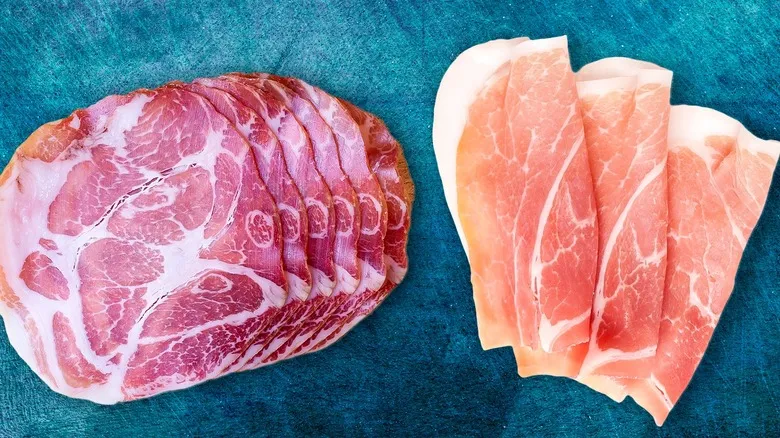What is capicola?
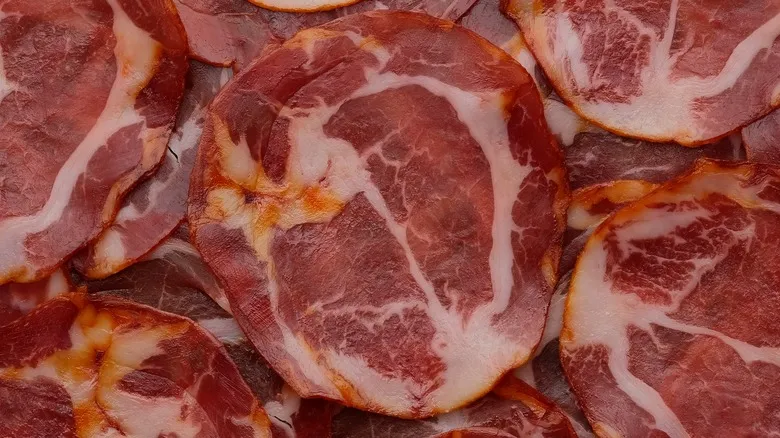
Capicola is an Italian cured meat made from the neck and shoulder of pork, specifically from the area between the neck and the fourth or fifth rib. It is also referred to as "coppa." The preparation of capicola involves dry-curing the meat for several weeks after it has been coated in a mixture of salt and spices. Once the salt is removed, additional spices such as paprika, red and black pepper, fennel, garlic, and anise are incorporated. The level of spiciness can be adjusted based on personal preference for heat and flavor. After applying the dry rub, the meat is placed in a pork casing, hung up, and dry-cured for six months. Various regional versions of capicola exist, each featuring its own unique blend of spices that contribute to distinct flavors. For instance, capicola from Calabria is known for its use of chili peppers for added heat, while the version from Parma is milder and relies more on salt for flavor.
Capicola is recognized for its favorable lean-to-fat ratio, typically around 70/30, which results in a tender texture. The fat content is visible in the meat's signature white striations once it is sliced.
What is prosciutto?
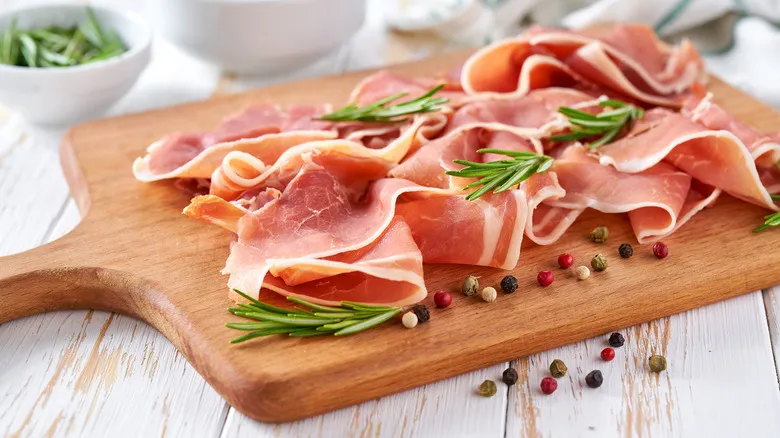
Although prosciutto and capicola are frequently served together and may be mistaken for one another at first glance, they are quite distinct. To begin with, prosciutto is a completely different cut of pork. While capicola is sourced from the shoulder and neck, prosciutto is derived from the pig's leg. In Italian, "prosciutto" translates to "ham," and it can be prepared in two primary ways: uncooked before curing, known as "crudo," or cooked prior to curing, referred to as "cotto."
The process of making prosciutto is intricate and time-consuming. Initially, the raw ham is salted and refrigerated for a week. Afterward, additional salt is applied, and the ham continues to rest for approximately 18 days. The salted ham is then transferred to a refrigerated environment, where it remains for about two to three months. Following this period, the salt is removed, and the ham undergoes curing for an additional three months. The curing process for prosciutto can last anywhere from 400 days to three years.
Unlike capicola, prosciutto is not seasoned with spices; it is simply salted. It is also categorized by region and safeguarded by stringent agricultural regulations. One of the most renowned varieties of prosciutto is prosciutto di Parma, which hails from the Emilia-Romagna region of Italy. By law, prosciutto di Parma must be cured for a minimum of 400 days.
What are the origins of capicola?
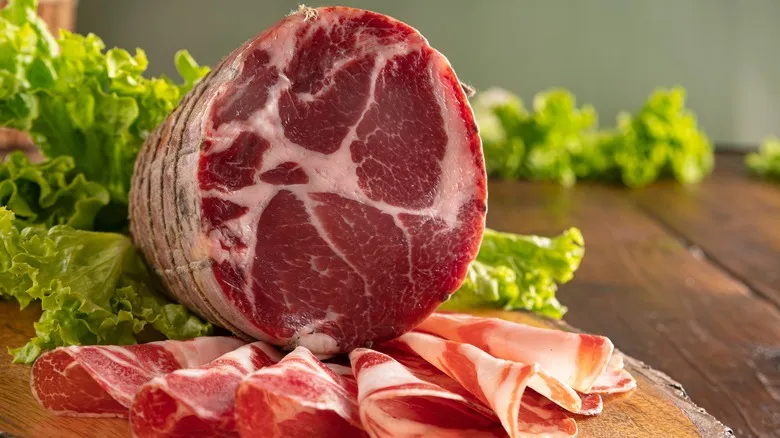
The practice of using processed pork has a rich history that traces back to the Etruscan period. Archaeological findings at Forcello, Italy, near Mantua, reveal a significant number of pig bones, all approximately 2 to 3 years old, with various limb parts missing. During the Roman Empire, ham products were featured at gatherings, and methods of preservation were developed to ensure that no part of the animal went to waste.
Cato the Elder, a Roman politician who authored "De Agri Cultura" around 160 BCE, provided instructions on how to cure ham with salt: "After the twelfth day, finally remove the hams, brush off the salt, and hang them in the wind for two days. On the third day, clean them with a sponge and rub them with (olive) oil. Then, smoke them for two days, and on the third day, apply a mixture of (olive) oil and vinegar. Finally, hang them in the meat house..." (via Project Gutenberg).
The exact moment when preserved ham evolved into distinct types of salumi—specific cuts prepared with particular seasonings and methods—remains unclear. However, it is believed that capicola originated in two regions: Piacenza in northern Italy and Calabria in the south.
How does capicola look?
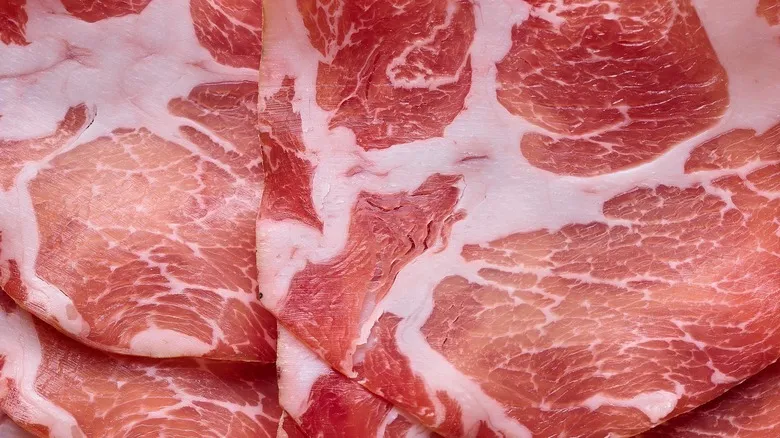
Chef Mario Gentile, the mastermind behind the Italian hotspot Adoro Lei in New York City, shared with Chowhound that when evaluating capicola, you should pay attention to "color and fat streaks." He notes that the appearance can vary by region, but ideally, the meat should range from bright pink to bright red. Capicola is characterized by its abundant fatty veins, giving it a distinctive marbled appearance. The exterior is coated with the seasoning used during the dry-curing process. Depending on the spices applied, the edge of the meat just beneath the surface may exhibit some color—particularly, you might see hints of orange if paprika is included. In the absence of vibrant seasonings, there will be no color bleeding from the outer layer to the inner portions.
Since capicola is a whole cut of pork, it can display various shades of pink and red. Additionally, if the meat is slow-roasted, it may lose some of its vividness. This contrasts with mixed-meat salumi, which is blended with seasonings before being dry-cured in casings, resulting in a more uniform appearance. In comparison, prosciutto has a different hue, often appearing pink or pinkish-brown, and capicola is a smaller cut than prosciutto.
How is capicola made?
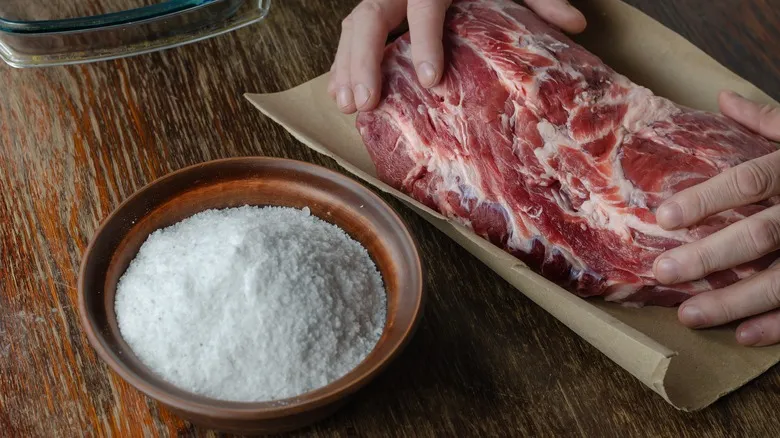
To make capicola, start by coating the pork shoulder and neck with a blend of herbs, spices, and salt, then allow it to cure for several weeks. After curing, rinse off the salt and add additional spices. Typical spices include paprika, red and black pepper, fennel, garlic, and anise. You can adjust the spice level to achieve your desired heat. Once the meat is thoroughly rubbed with the spice mixture, it is stuffed into pork casings, hung up, and left to dry-cure for six months.
Feeling adventurous? You can definitely try making capicola at home! Visit your local butcher to buy a fresh pork shoulder, casings, and a curing salt mix. Season the pork shoulder to your liking; while traditional seasonings are great, feel free to incorporate your favorite spices for a unique twist or to experiment with different flavors. Trim the meat, apply salt and seasonings, then wrap it tightly in plastic wrap and let it cure in the refrigerator for a few weeks. After that, place it in the casing. Be prepared to be patient—the capicola needs to hang and age for about three to six months, depending on the size of the cut. The ideal aging temperature is between 50 and 60 degrees Fahrenheit. Once it's ready, slice it thin and enjoy!
What does capicola taste like?

This is where the variety of spices and the specific type of pork come into play. For instance, Coppa Piacentina, produced in the Emilia-Romagna region of Italy, must come from pigs that are born and raised in either Emilia-Romagna or Lombardy. Similarly, Coppa di Calabria is sourced from pigs raised in Calabria, Italy. These are specialty products that are protected and have received PDO (Protected Designation of Origin) status. However, capicola can be made anywhere there is a pork shoulder and suitable aging conditions. Chef Mario Gentile shared with Chowhound that his favorite is capocollo di Martina Franca from Puglia, which is smoked using the bark of the Fragno oak and almond tree husks.
When it comes to spices, capicola typically has a smoky flavor and may possess more heat compared to other salumi, though it isn't always spicy. There is considerable flexibility regarding the spices used. In terms of flavor and texture, capicola should be salty with a delightful creaminess due to its high fat content.
When to use capicola
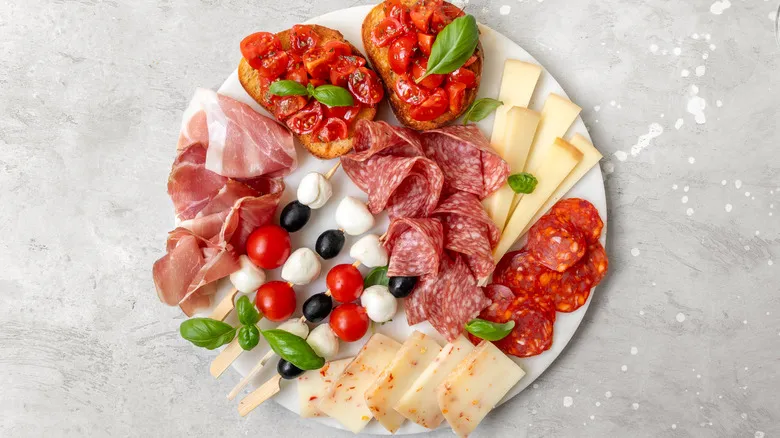
"Capicola is best enjoyed as it is," Mario Gentile shared with Chowhound. He suggested incorporating it into "cold dishes like charcuterie boards, tomato salads, cheese platters, or sandwiches." Capicola makes a fantastic addition to your classic antipasto platter—pair it with other Italian finger foods such as olives, roasted red peppers, and Sicilian caponata, along with cheeses like provolone, Parmigiano, and sharp cheddar. Adding figs, pears, and apples can enhance the experience. You might also consider including other meats like prosciutto or salami for a variety of flavors. And don’t forget to serve some Italian bread alongside these delicious treats!
Capicola is also an essential ingredient in any Italian sandwich. A traditional Italian sandwich (known as a hero, hoagie, or grinder depending on the region) typically features a combination of these classic ingredients: assorted pork meats like capicola, salami, pepperoni, and prosciutto, along with tomatoes, lettuce, onions, mozzarella or provolone cheese, pepperoncini, and an oil-and-vinegar dressing on an Italian loaf. While there are many variations, capicola is often a staple.
When cooking at home, capicola is a simple way to elevate everyday dishes. Consider wrapping capicola around asparagus or chunks of cantaloupe. "For more 'experimental cooking dishes,' [capicola] can be sliced very thin and added to veal scallopini or chicken dishes after plating," Gentile noted. You can also layer it on chicken breasts for a straightforward yet flavorful take on chicken saltimbocca (though prosciutto can be used as well).
Where to buy capicola
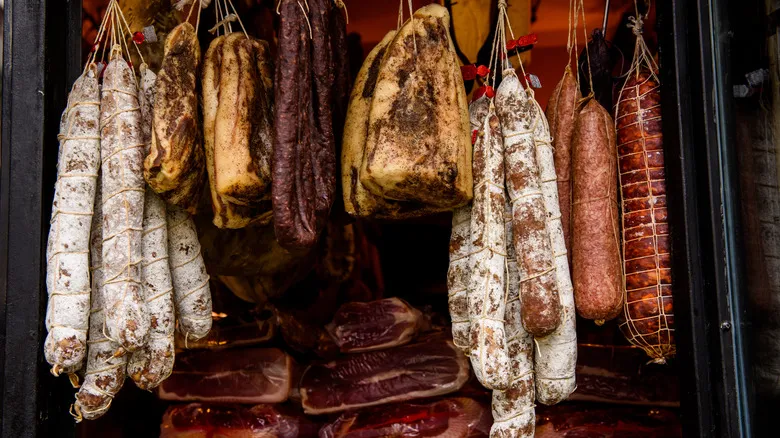
Capicola is available at any salumeria, delicatessen, or Italian specialty shop, as well as select grocery stores. The quality and price can vary significantly based on the type of capicola you decide to buy. Some options are pre-packaged, while others need to be sliced fresh from the butcher. You can also find pre-sliced capicola or order a whole pork shoulder to cut yourself, depending on how hands-on you want to be in the process.
While it's always enjoyable to see the meat before it's sliced, you can also order capicola online from Amazon, with options for both sliced and unsliced varieties at different price ranges. Some highly-rated retailers include Olympia Provisions, Supermarket Italy, Fortuna's, the Calabria Pork Store, Claro's Italian Market, Eataly, and Meat N' Bone. However, it's advisable to visit a store in person to see and sample the meats; you might discover some unexpected favorites!
What to look for when buying capicola
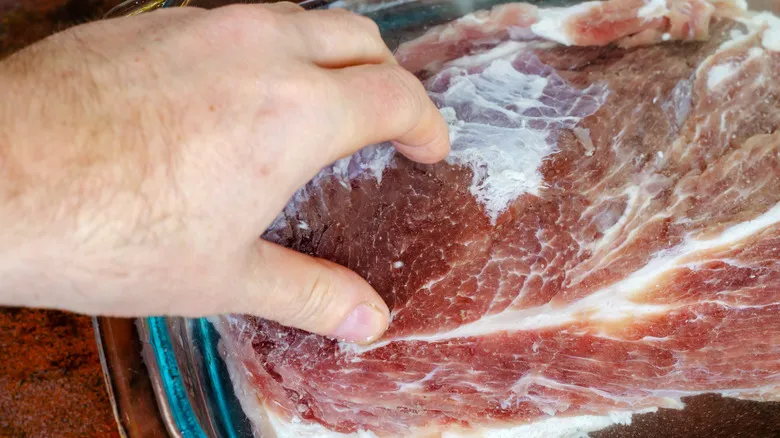
When purchasing sliced capicola, look for a pinkish-red hue along with the characteristic white fat streaks. These features indicate that the meat is fresh, tender, and likely delicious. It should be sliced thinly, as this is a fundamental rule for authentic Italian cold cut sandwiches. In terms of freshness, the meat should not have an unpleasant odor or a grayish appearance. If you're opting for pre-packaged capicola, be sure to check the expiration date.
Consider the seasonings you prefer as well. As mentioned, there are various ways to season capicola during its aging process. While you may not always be able to identify the specific seasonings just by looking, a reddish-orange tint at the edge of the cut suggests the presence of paprika or red pepper, indicating that the meat may have a bit of spice. If you're feeling uncertain or overwhelmed by the options, don’t hesitate to ask for assistance. Your deli professional or butcher should be well-informed about the types of capicola they offer and their flavor profiles. When buying sliced capicola, only purchase what you need, as it is best enjoyed fresh.
How to store capicola
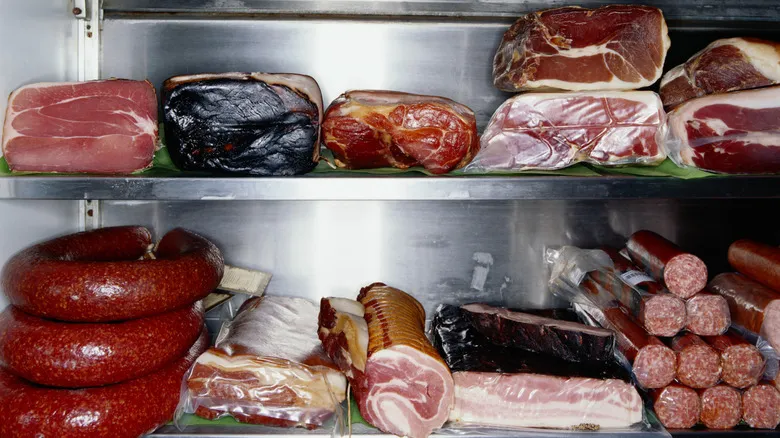
Cured meats like capicola and prosciutto should be kept in a cool environment, preferably in the refrigerator at around 40 degrees Fahrenheit if they are pre-sliced. For whole cuts of meat that haven't been sliced yet, a cool cellar is suitable for storage. This is important because cured meats can develop bacteria when exposed to light or oxygen after being opened. It's important to avoid storing capicola in the pantry. If you wish to freeze sliced capicola, make sure to vacuum-seal it and consume it within one to two months.
Once opened, capicola should not be consumed after five days. It’s best to keep it wrapped tightly in its original deli paper or in an airtight container. Some people opt to vacuum-seal their cured meats for added protection and to prevent them from drying out. Pre-packaged meats usually come with an expiration date, but proper storage is crucial to ensure they remain safe to eat. If the meat appears grayish, discolored, or moldy, or if it has an unusual smell or taste, it’s best to discard it.
Recommended
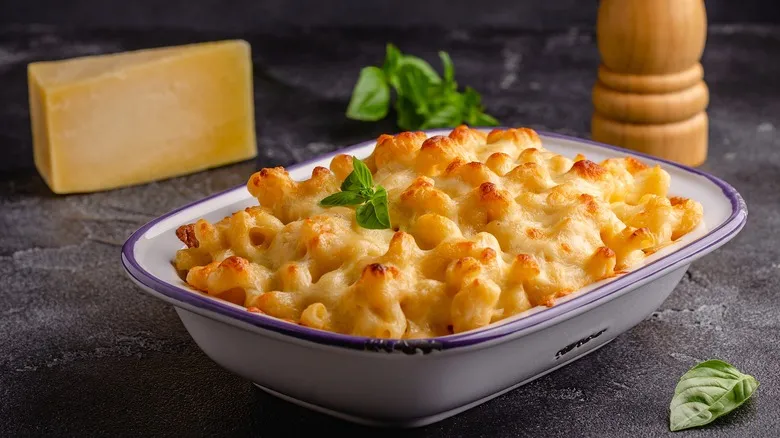
The 2-Ingredient Mac And Cheese Sauce That Will Save You Time At The Stove

Bring A Smoky Essence Into Your BLT And Grill The Bacon
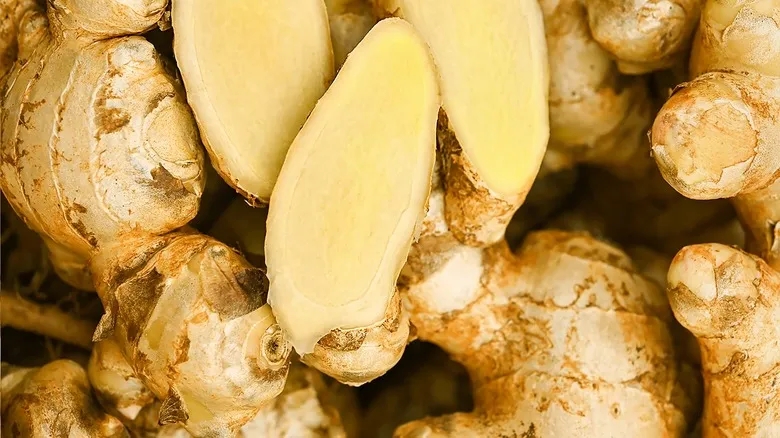
You Should Start Adding Ginger To Your Burger Mix

The Flavor-Packed Ingredients Ina Garten Uses To Avoid Boring Pasta Salad
Next up

